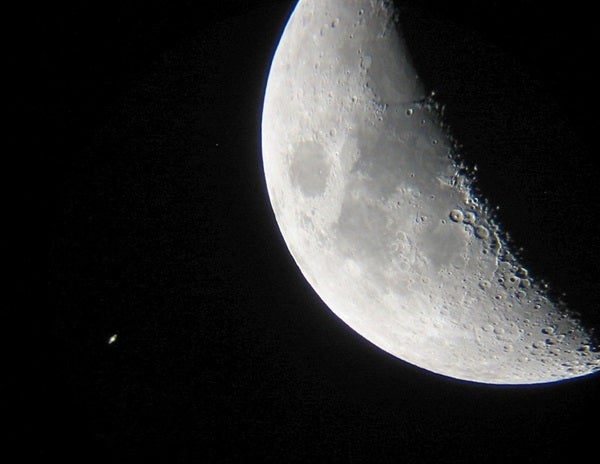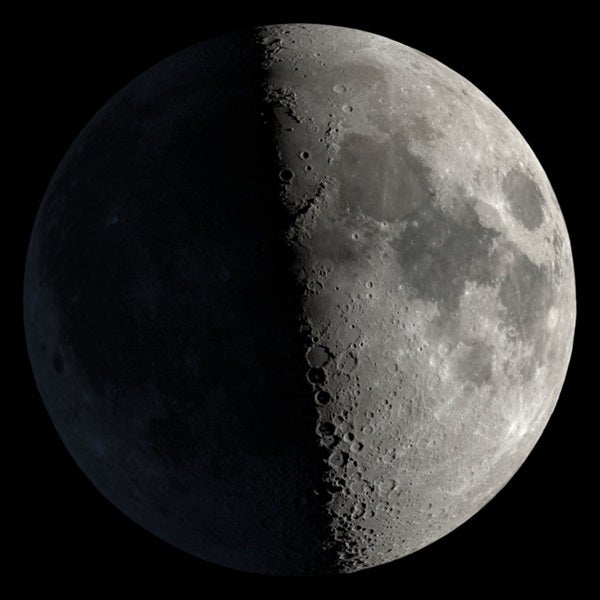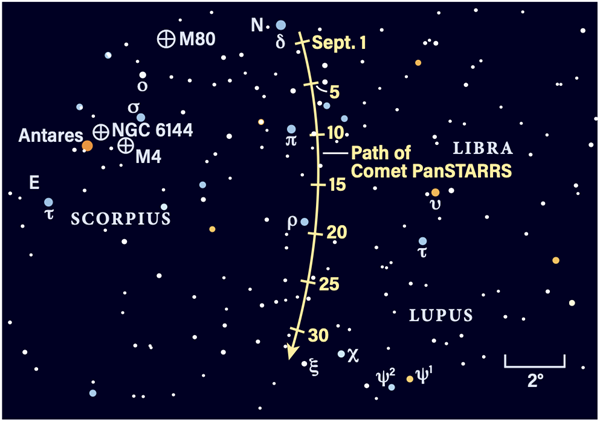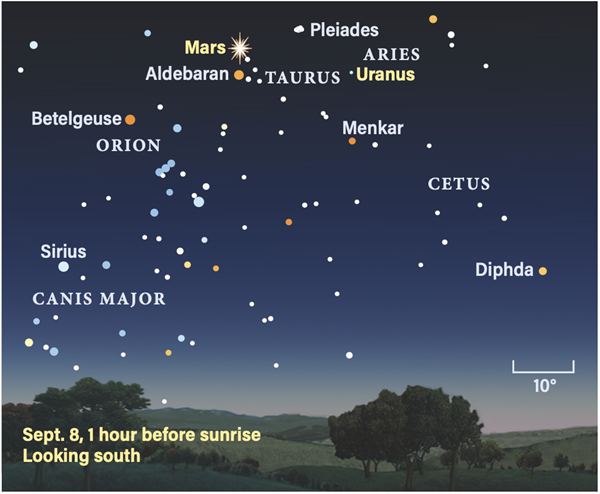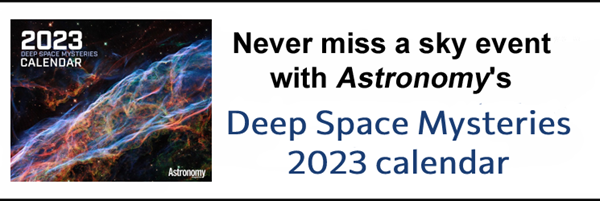Friday, September 2
The crescent Moon hangs in the southern sky at sunset. As darkness falls, turn your telescope on the lunar terminator, the line that divides night from day. You’ll notice that two large craters really stand out: These are Hipparchus (the northernmost or topmost of the two) and Albategnius just below it.
Hipparchus is the older of the two — and you can tell, when you compare its more battered rim to that of more clearly defined Albategnius. Plus, Hipparchus’ floor, which is higher compared to its rim than Albategnius’, features more pockmarks because it’s been exposed to the ravages of time for longer. Albategnius, meanwhile, has a deep, round crater interrupting its western rim, called Klein.
Enjoy these and the many other craters currently sitting near or along the terminator. Then, come back a few days later and take another look. The terminator has moved significantly as the Sun climbs higher in the lunar sky. Compare the two craters again and note that shallower Hipparchus will have almost disappeared under the higher Sun angle.
Sunrise: 6:29 A.M.
Sunset: 7:30 P.M.
Moonrise: 1:06 P.M.
Moonset: 10:52 P.M.
Moon Phase: Waxing crescent (38%)
*Times for sunrise, sunset, moonrise, and moonset are given in local time from 40° N 90° W. The Moon’s illumination is given at 12 P.M. local time from the same location.
Saturday, September 3
First Quarter Moon, when our satellite’s face reaches 50 percent illuminated and the terminator splits it down the middle, occurs at 2:08 P.M. EDT.
For now, though, the Moon remains in the evening sky — so the time is right to try your hand at spotting the zodiacal light, which appears before dawn and spreads across the ecliptic, the plane of the solar system. Its soft glow results from sunlight scattering off fine dust particles left in the wake of comets as they shed debris on their repeated trips through the inner solar system.
To up your chances of spotting zodiacal light, you’ll want clear eastern skies free of local light pollution. Step outside a few hours before dawn, while the sky is still dark with no traces of morning twilight. The zodiacal light will arc upward from the eastern horizon toward the upper right (west), through Cancer and Gemini and toward Taurus, which currently hosts Mars just 5° northwest of the bright red giant star Aldebaran.
Sunrise: 6:30 A.M.
Sunset: 7:28 P.M.
Moonrise: 2:19 P.M.
Moonset: 11:36 P.M.
Moon Phase: First Quarter
Sunday, September 4
Venus passes 0.8° north of Regulus at 9 P.M. EDT. Neither is visible above the horizon at that time, but you can catch them before sunrise instead, when Venus appears northwest of the star, standing nearly directly above it in the morning sky. The blazingly bright planet is magnitude –3.9, far outshining 1st-magnitude Regulus, normally considered a fairly bright star. Depending on your location and your altitude, the two are visible starting about 50 minutes before sunrise in the east, slowly rising upward from the horizon in the brightening dawn. See if you can spot the fading Sickle of Leo, which starts at Regulus and forms a backwards question mark running through Eta (η) Gamma (γ), Zeta (ζ), Mu (μ), and Epsilon (ϵ) Leonis. This asterism also outlines Leo’s head, which faces west (upward) on the sky as the Lion appears to sit in profile.
Through a telescope, Venus is nearly full (98 percent lit) and spans 10″, roughly the same apparent size as Mars, high above in Taurus.
Sunrise: 6:30 A.M.
Sunset: 7:27 P.M.
Moonrise: 3:31 P.M.
Moonset: —
Moon Phase: Waxing gibbous (61%)
Monday, September 5
Comet C/2017 K2 (PanSTARRS) is still the brightest comet in the sky, currently observed around magnitude 9 — slightly fainter than predicted, though of course, comets are notoriously unpredictable. Still, you can catch it with a telescope under good skies, and you’ll want to start early: some 15 minutes after nautical twilight if possible. That’s because the comet has moved from Ophiuchus down into Scorpius, closer to the southwestern horizon.
Tonight, the comet sits nearly between Pi (π) and Delta (δ) Scorpii, in the center of a small triangle formed by three 5th-magnitude field stars. Drop just 2.2° south-southeast of Delta to find it. Compare the comet’s round, fuzzy coma to nearby M80, a globular cluster 2.7° north of Sigma (σ) Scorpii. The light of the globular cluster, full of old stars, should appear slightly warmer than that of the comet.
While you’re in the region, be sure to take in the warm, ruby glow of Antares, the Scorpion’s famous heart. This star is so named because its moniker means “rival of Mars” — the two appear similar in color to the human eye, though Antares’ light comes from within, while Mars’ is just sunlight reflecting off rusty soil.
Sunrise: 6:31 A.M.
Sunset: 7:25 P.M.
Moonrise: 4:35 P.M.
Moonset: 12:29 A.M.
Moon Phase: Waxing gibbous (72%)
Tuesday, September 6
A gibbous Moon tonight sits smack dab in the middle of the handle of the Teapot, a famous asterism in Sagittarius the Archer. Still, we’ll try our luck at finding the Dumbbell Nebula (M27), some ways away in Vulpecula the Fox. The easiest way to locate this planetary nebula is to look about 3° north of magnitude 3.5 Gamma Sagittae, the brightest star in nearby Sagitta the Arrow.
Normally, you could see the Dumbbell well with binoculars, thanks to its apparent size and brightness: some 8′ by 6′ and magnitude 7. But with the Moon nearby, a telescope may be best to bring out this target tonight. So called because of its apparent hourglass or dumbbell shape within a larger, more diffuse spherical glow, M27 may look simply rectangular with hints of a tapered waist, depending on the size of your aperture and, temporarily, the glare from the Moon. If you want to bring out more detail, simply be patient and wait for the Moon to move farther away and begin waning again, then come back to revisit this region of the sky and compare the view then.
Sunrise: 6:32 A.M.
Sunset: 7:24 P.M.
Moonrise: 5:31 P.M.
Moonset: 1:35 A.M.
Moon Phase: Waxing gibbous (82%)
Wednesday, September 7
Asteroid 3 Juno reaches opposition at 1 P.M. EDT in Aquarius, meaning it is visible all night, from dusk until dawn. The main-belt world sits 4° northwest of 4th-magnitude Phi (ϕ) Aquarii, and glows at magnitude 7.7. That’s bright enough to pick up with binoculars or any small scope. It lies just over half of the distance between two field stars, one 7th magnitude and the other 9th. (Juno is closer to the fainter star.)
If you’d like a target that’s just a little brighter, you don’t have to go far: 4 Vesta is now 6th magnitude and also swimming through Aquarius, though on the constellation’s southern side and much closer to the Moon’s current location. Drop about 7.2° directly down toward the horizon from Deneb Algedi in Capricornus to find it. Again, the nearby Moon may make spotting even this brighter asteroid a challenge, so if you’re finding yourself frustrated, just wait about half a week and the Moon will have moved on, though both asteroids will have moved a bit, too. Check out the Locating Asteroids section of September’s Sky This Month for a chart showing how to find Vesta all month.
The Moon reaches the closest point to Earth in its orbit, called perigee, at 2:19 P.M. EDT. At that time, our satellite will sit 226,485 miles (364,492 kilometers) from us.
Sunrise: 6:33 A.M.
Sunset: 7:22 P.M.
Moonrise: 6:16 P.M.
Moonset: 2:48 A.M.
Moon Phase: Waxing gibbous (90%)
Thursday, September 8
The Moon passes 4° south of Saturn at 7 A.M. EDT, though the pair sets several hours earlier, around 4 A.M. local time. If you want to glimpse them before they disappear, try an hour or so before that — around 3 A.M. local time — and look southwest to find the nearly Full Moon hanging some 5.5° south-southwest (to the lower left) of Saturn, which is glowing at magnitude 0.3. Despite the bright moonlight, the planet should still be visible; in fact, it may be one of the only points of light still easy to see in that region.
If you prefer to get up just a little later, Mars rides high in the southern sky, now standing a little more than 4° directly above Aldebaran, Taurus’ brightest star. Compare and contrast their colors — like Antares, Aldebaran is a red giant star whose light has a warm orange-red glow. Mars is magnitude –0.2, somewhat outshining Aldebaran’s magnitude 0.9. The Red Planet will pass 4° due north of Aldebaran at 9 P.M. EDT.
Nearby, just over 11° west-northwest of Mars, is the lovely naked-eye Pleiades Cluster (M45). See how many stars in this small, dipper-shaped grouping you can make out without any optical aid. Then, use binoculars or a telescope at low power — or even your finder scope — to bring out many more of this cluster’s young suns.
Sunrise: 6:34 A.M.
Sunset: 7:20 P.M.
Moonrise: 6:53 P.M.
Moonset: 4:06 A.M.
Moon Phase: Waxing gibbous (96%)
Friday, September 9
Mercury stands stationary against the background stars of Virgo at 4 P.M. EDT. It will now halt its eastward motion and begin heading west toward the border of Virgo and Leo, and back toward the Sun as well.
The best time to view the solar system’s smallest planet today is just after sunset — in fact, you’ll need to be pretty quick. Twenty minutes after the Sun disappears, Mercury is just 1.5° high in the west. You’ll want a clear view of the horizon to catch it, glowing at magnitude 0.8. Binoculars or a small telescope will help. The planet’s face is now just over a quarter lit and spans 9″ on the sky. See if you can spot the small pinprick of light that marks magnitude –0.1 Arcturus in Boötes, one of the brightest stars in this part of the sky, some 37° above Mercury. This is likely one of the first stars that will pop out in the evening twilight.
Mercury will set earlier each night, so this week is one of your last chances to see the planet before it reaches inferior conjunction later this month.
Sunrise: 6:35 A.M.
Sunset: 7:19 P.M.
Moonrise: 7:24 P.M.
Moonset: 5:23 A.M.
Moon Phase: Waxing gibbous (99%)

